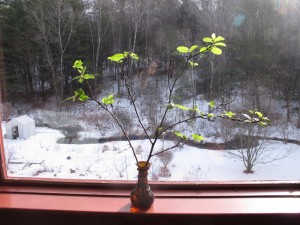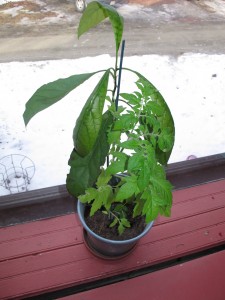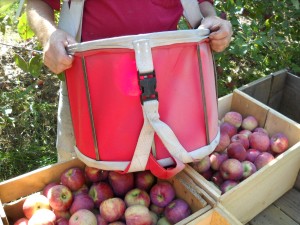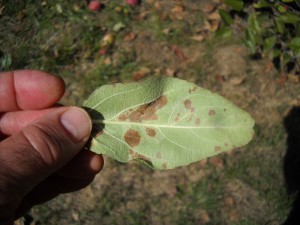Getting through the Doldrums
When pruning a Merrill magnolia last November, I brought home a few stems that had nice fat flower buds and put them in a vase of water. I put them in a south-facing window and pretty much forgot about them. From time to time I admired the smooth gray bark and handsome branching patterns. But then in the first week of January, those stems developed lovely green leaves! And the flower buds are swelling and look as if they might bloom, too – but even if they don’t, my spirits are lifted by seeing some green leaves.
Forcing blossoms of tree branches (making them bloom early indoors) is normally something I do in March, when I am pruning apple trees. I always bring in some branches and enjoy both the leaves and flowers of stems I have cut. At that time of year the trees are already “thinking” about opening up their buds, and it only takes a week or two for them to open up on a sunny windowsill.
But this year, I am going to cut apples, forsythia, lilacs and other spring-blooming trees and shrubs starting now. Each week I shall snip a few branches and experiment with forcing. I have never tried forcing lilacs, for example, and since they are mid-to late-spring bloomers, I would normally hold off until nearer the time that they normally break dormancy –perhaps in April. But why not try now? I have read that one can encourage branches to break dormancy by submerging them entirely in a bathtub of water and will give that a try.
When you select branches for forcing, be sure to pick some that have flower buds. Flower buds are generally fatter than leaf buds. On apple trees, flowers are generally found on fruit spurs. These are 2- or 3-inch long stems that end in fat buds. The buds contain both leaf and flower buds. For many varieties, fruit spurs must be more than a year old in order to produce flowers (and hence fruit). Last year’s water sprouts (vertical whips) on apples will produce leaves but not flowers.
Almost any tree can be forced, but many do not have flowers that are colorful, so we often ignore them. Do you know what a maple or poplar blossom looks like? Their small green flowers are not much appreciated – and I have never cut them to put in a vase. You certainly recognize pussy willows as signs of spring, but do you think of those furry fellows as flowers? They are flowers, and can give me as much pleasure in February as my roses will later on.
For best results, cut stems of trees according to their natural schedule. That means picking early bloomers now, and later bloomers in February and March. Here is a rough schedule: In January cut forsythia , willows and poplars. In early February cut red maples, alder, quince, birch and cherries. Later in February try rhododendrons, azaleas and pussy willows. Then in March try cutting branches of hawthorns, shrub honeysuckles, apples, crabapples, mockorange, lilacs, and spirea.
Elsewhere in the house I was recently surprised by a tomato plant that appeared in a pot where I have an avocado growing. The avocado was one that I dug out of the compost pile last fall – along with a tomato seed, apparently. Most grocery store avocados do not have viable seeds, as the seeds need to be fresh (picked within 3 weeks of planting) in order to grow.
I remember as a boy suspending an avocado seed in a glass of water by toothpicks. It sent roots down into the glass, and then sent up a stem. I planted the seedling in a pot, creating a nice houseplant with glossy green leaves. But since the avocado industry now stores and sells avocados all year, the seeds are usually too old to grow. But I guess last summer I threw a few fresh avocado seeds into the compost because three seeds grew!
But what about that orphan tomato growing with my avocado? I am going to give it every benefit. I have heard about people who have gotten tomatoes to bloom and produce fruit indoors in winter, though I have never done it. To help mine along I have hung a light over it in the window where it is growing. I am using an LED light that uses very little energy and produces a lot of light from its 45 little LED bulbs. It’s produced by Sunshine Systems (www.sunshine-systems.com) and uses just 28 watts of power while providing the light of a 250 watt hps lamp.
I realize that my tomato might not produce tasty fruit even if I get some. It all depends on the seed: it will be fine if it came from an heirloom tomato (which is mostly what I grow), but if it’s from a hybrid tomato plant, it might produce an undesirable fruit. Hybrids most often revert to the parent types, which may not be tasty. Still … it’s winter, and I’m game to try almost anything to feel like a gardener.
Henry Homeyer is the author of 4 gardening books and lectures on gardening throughout New England. He can be reached at henry.homeyer@comcast.net.
Apples!
I read my first piece of propaganda when I was eight, maybe nine years old. It was a biography of Johnny Appleseed. It was one of a series of library books, all with orange covers, large print, and just a few simple drawings. They were fascinating, every one of them. Johnny, I learned, was a happy-go-lucky sort who walked around America giving away apple seeds. Not so. Johnny was a businessman who sold apple seeds and seedlings so frontier folk could make hard cider and its distilled companion, applejack. Most of the apple trees back then were what we would call wild apples – those that we wouldn’t consider good eating apples.
Here’s my quick course on apples: any named apple variey today is genetically identical to all others of the same name. That’s right. All Macs or Cortlands are the same, genetically, as all other Macs and Cortlands. Before you buy a tree, someone has grafted scions (living twigs) onto root stock to produce a tree that will give you tasty apples of a named variety. Some nurseries even sell trees with 3 or 4 different varieties grafted onto one tree.
The roots affect whether your tree is full sized, mid-sized or dwarf. Most new apple varieties – Macouns, for example – are hybrids developed by apple researchers, tested and then propagated by grafting – not by seed. So don’t plant seeds from your favorite apple thinking the tree will be like the mother apple.
Apple trees are easy to grow – you should have one, or perhaps more. Not only that, one can grow good eating apples without using toxic chemicals, although most orchards use some chemicals to control apple scab and sometimes insect pests. Americans have grown very fussy about their food, demanding perfect fruit, unblemished by even a spot of blight, which makes the orchards spray. The home grower can eat organic fruit with a few small brown spots, or cut them out.
I recently visited Paul Franklin at his farm, Riverview Orchard, in Plainfield, NH; he has been growing apples for sale for over 25 years, and is a wealth of knowledge. One of my first questions to Paul was this: how do you know when an apple tree is ready to pick? It’s easy, he said. Just cut open an apple and look at the seeds. If they are tan to dark brown, the apple is ready. Paul added that some apples resist coming off the tree, even when they are fully ripe while others are easy to pick even when still green.
What about that film often seen on apples? It’s not a pesticide, Paul said, but Mother Nature at her best. It is a thin film of wax, which protects the apple. Polish it a bit, and the apple shines. Some apples have more wax than others.
This past spring many apple blossoms were damaged by a period of unusual warmth that was followed by a hard frost. The frost damaged the opening buds, so many of us lost all or most of our apples. I live in a cold spot and lost all mine. Paul Franklin’s orchard is near the Connecticut River, so the little bit of heat released by the water minimized his losses. If you are choosing a site to plant apples, remember that near the top a hillside is a good spot. Cold air is dense, and tends to slide down hill. Often only a degree or two can make the difference between success and failure.
I asked Paul about his favorite apples. He said that Cortland and Honey Crisps are two of his favorites. Honey Crisp is tasty and somewhat resistant to apple scab. Cortlands are great apples for both eating and making pies. Honey Crisp are great keepers – a customer of his picks a bushel of them, then stores them in a spare fridge for up to a year. If you do that, don’t store other vegetables in the fridge because apples give off ethylene gas, which prompts other veggies to age and go past their prime.
If you planted an apple tree recently be sure to protect the bark with a collar of quarter-inch hardware cloth (metal screening). An 18 inch square can be used to wrap around the base to keep meadow voles (voracious mouse-like creatures) from nibbling the bark in winter. If a vole eats bark all the way around a trunk it will kill the tree. Dig the screen in an inch to keep them from going under it. After 5-7 years the bark is thick enough that the hardware cloth is not needed.
What else can you do for your apple trees now? In order to minimize apple scab and other diseases, rake up the leaves under your trees. Scab overwinters on leaves. Mowing under trees helps, too – chopping up the leaves and helping them to break down. Young trees benefit by a little slow release organic fertilizer in the fall, but older trees do not need it.
So go pick some apples on a warm sunny fall day. Eat plenty, make a pie, save some for winter. And thank Johnny Appleseed – if you believe in the propaganda.
Henry Homeyer’s Web site is www.Gardening-guy.com. Henry’s upcoming kid’s fictional chapter book, Wobar and the Quest for the Magic Calumet, is just out. Check for Wobar at your local bookstore or go to henryhomeyer.com to learn more.






